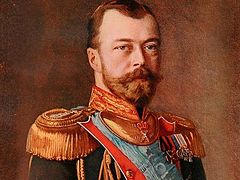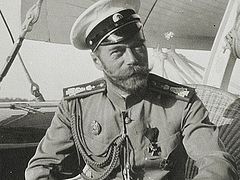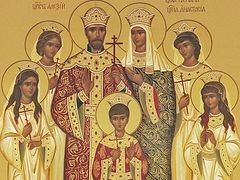For the 100th anniversary of the martyric death of the Royal Family, Sretensky Monastery published the book of Archpriest Alexander Shargunov Tsar: A Book About the Holy Royal Passion-Bearers. Fr. Alexander regularly preaches about the holy Royal Passion-Bearers on the “Radonezh” Orthodox radio station, answers readers’ letters in the journal “Russian Home,” and is the compiler of several collections of miracles of the Royal Martyrs. This book is about the role of monarchy in Russia’s fate, about the path of confession of the last Russian emperor and the members of the august family, and about the miracles manifested by prayers to the Royal Martyrs.
Cesar Golodny, the son of the famous poet and “singer of the revolution” Mikhail Golodny, an unbeliever, extremely rational, told me in the early 1960s that in the war, when he was fourteen, he and some other youngsters put out incendiary bombs on rooftops. One day, in one of the buildings in the attic, a wooden box fell on them from somewhere above. It cracked and split, and they saw a large portrait of Nicholas II in a gilded frame. The boys were gripped by a horror that they themselves did not understand. They stood spellbound and looked at the portrait. What where they afraid of? Of touching something forbidden and unbelievable in the midst of soviet reality? After all, at that time, under Stalin, they could accuse you of concealing a portrait and give you a long sentence. Go and prove otherwise. One fact alone, that they saw it, was already criminal, visual anti-soviet agitation from the point of view of the authorities. “No,” Cesar said, “it was a completely different kind of fear. There were funerals going on then, one after another…” and he started naming the young men killed in the war, a little older than him, from his block.
“What is the connection between the war and the Tsar’s portrait?” I asked. “The thing is that here in the attic, something happened that enlightened my consciousness like lightning: As in some strange kaleidoscope, the Tsar, and this war, and our entire life were joined into one thing,” he said. “Looking at the Tsar’s face, I suddenly and clearly realized that retribution exists. We ran out, leaving the portrait in the attic and never discussing this event with one another. But what was revealed to me then has always remained in my soul.”
A photograph of the Tsar
A miracle is not just a clear grace, not just an event outside the external order of things, but it is a meeting that remains for life. It’s something that affects the soul such that something changes in it forever. The truth is exposed, which is higher than all conversations and words, and it is made obvious. The veil of lies is pulled back and the mysterious becomes clear. Although, in soviet times, everything was done so that nothing would remind people of the Tsar and his image appeared only in caricatures, but he continued to remind many people about himself. For some it was enough to look at a photograph in order to understand something.
A parishioner of our church, Anna G., says that when she was ten (in the Stalin years), she saw a photograph of the Tsar and his family for the first time in the pre-revolutionary journal Niva. “The Tsar’s face struck me because it seemed familiar, and, of course, because of his amazing comeliness and nobility. ‘This is indeed a real tsar,’ I thought. Photos of his wife and children evoked feelings of awe in me. I realized that these were people of the highest order, the likes of which could not be found in those around me. Their faces had such a closeness, as if they are ready to be a part of your life. Since then, I’ve never accepted any slander against the Royal Family. And one thought relentlessly pursued me: How could such a family be executed?”
A miracle is a recognition; as a nursing child, growing up from infancy, out of all the innumerable faces knows its mother, as in marriage you know your betrothed: “I recognized him,” “He recognized me.” This recognition is a great happiness, whether in terms of personal life or in terms of national fate. One woman told me how she prayed in her childhood that she would be given to know what happened in 1917. Her parents told her that the issue is there were honest and dishonest Bolsheviks. Then she had a detailed dream in which the truth was revealed. In this sense, the photograph of the Tsar was like a dream. God rewards those who hunger and thirst for the truth, but God does not love those who hide from the truth, deceiving themselves. (“We don’t need to know that,” they say with fear.) But the Supreme Being and the higher world responds to the desire for truth, going out to meet it, so that it’s revealed even to some hardened dissident that it’s not a matter of politics.
The soul initially knows everything, because it is Christian by nature—it’s just that not everything happens immediately. In Stalin times, there was a third-grade girl in Moscow who invited her friend to her house, as if inviting her to something secret and forbidden: “Let’s go, I want to show you something.” She had a hidden picture of the Savior and illustrations from the Dore Bible. “I saw something familiar,” this girl’s guest recalled many years later, “something I’d always known and just had to remember. ‘Who is He?’ I asked her. ‘He is fully Russian,’ she confidently answered.” And in this infinitely naïve answer was, in fact, a high theology: In every person and every nation, only that which belongs to Christ is genuine.
Is not this story consonant with what happened with the photograph of the Tsar? When I was speaking with Anna G. about her reminiscences, she said, “I didn’t really comprehend the photograph, but his face really struck me. It is significant; it is warm. It was obvious that he was put in place by God to be the tsar and that he was necessary for everyone. He had the mark of a particular holiness. I didn’t dare pronounce that word then, but that’s exactly what I felt. In any case, it played a role in my rejection of sovietism, and later helped me understand a lot on my path to faith.”
I listened to her and thought, no matter how you look at the Tsar, no one can deny that his face is always full of genuine significance; and also about how the icon of the Tsar in the Church Abroad is basically just a photograph with a halo, and some photos of the Royal Martyrs are considered as icons. It’s no accident that in many Orthodox homes they hang together with the icons.
Description of the portrait-icon of the holy Passion-Bearer Tsar Nicholas II
In early September, a recently painted portrait of the Tsar was given to our church in the name of St. Nicholas in Pyzhi. It’s a very unusual portrait, different from all the known images of him. It’s full of alarm, and the feeling of the blowing wind and moving clouds, as if he’s being depicted on a banner waving in the wind; you can hear the military march and at the same time the hymn “God Save the Tsar.” The Tsar has a mournful look, in which you can read what great trials await Russia, and how hard it is for him to see it.
The tsar is watching closely, whether we will be co-laborers with the holy martyrs who pray for Russia, or whether we will betray it with our indifference and inaction. He is as if calling us to battle, taking part in it and calculating what move to make.
We feel the spiritual power of a leader who seems to be saying, “Be brave, I will help you!”—the spirit of a warrior-king, exacting vengeance for his people. He is the commander-in-chief, in whose eyes there is calm and determination. The splendor of his striking eyes, like those of Archangel Michael, is a sword. The fate of Russia is being decided. I came not to send peace, but a sword (Mt. 10:34), says the Lord.
The uniqueness of this portrait is that it’s not like a portrait from memory, but an image of what the Tsar became. He looks out from a place where there is neither sorrow nor sighing, and he won’t be returning. It is no longer the flesh of the Tsar, but his soul.






